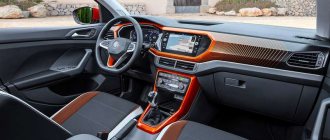Volkswagen Golf is one of the best-selling models of the Volkswagen company. The Fifth Golf debuted in 2003 and was produced until 2008. It is based on the Volkswagen Group A5 (PQ35) platform. The Golf 5 retains the model's signature silhouette. Compared to its predecessor, it has grown noticeably: by 5.5 cm in length, by 2.5 cm in width and by 4 cm in height. The interior has become noticeably more spacious.
More interesting changes are hidden under the body. For example, an air conditioner, which, when using a windshield washer, automatically turns on internal air recirculation in the cabin. Thus, it protects passengers from the unpleasant odor of liquid.
There are bigger innovations too. So, instead of a torsion beam, a multi-link suspension was installed at the rear. Moreover, you don’t have to worry about its durability. It turned out to be quite durable. And the Golf began to handle just great.
Engines
Volkswagen Golf V was equipped with naturally aspirated gasoline engines with a displacement of 1.4 liters (75 - 90 hp) and 1.6 liters (102 hp). Among them were FSI direct injection engines with a capacity of 1.4 liters (90 hp), 1.6 liters (115 hp) and 2.0 liters (150 hp). In 2006, the line of gasoline engines was diluted with turbocharged 1.4 TSI engines with power from 122 to 170 hp. Diesel engines were represented by two units - 1.9 TDI (90-105 hp) and 2.0 TDI (140 hp). Sports versions of the Golf GTI were equipped with a 2.0 TFSI engine producing 200 hp.
All engines are quite reliable, but there are a couple of points that you should pay attention to when buying a used fifth-generation Golf. Let's look at the most common engines.
Let's start with the naturally aspirated 1.6 modifications BSE and BSF with a timing belt drive. Shaking at idle speed is normal for such an engine. In any case, it is almost impossible to cope with such a phenomenon. Unless in rare cases the situation can be corrected by new ECU firmware. 1.6 liter engines begin to eat up oil no earlier than 150 - 200 thousand km. The sound of the exhaust in the area of the exhaust trousers-corrugation-catalyst connection, reminiscent of “cutting”, is another feature of the 1.6-liter engine.
For 1.4 TSI SAHA and BMY engines, a crackling sound when starting up after a long stay, “diesel” rattling for the first 10 minutes or slight shaking (detonation) at idle speed after 40 – 60 thousand km are not uncommon. The reason is a failed valve timing regulator (about 30,000 rubles for the original). It must be replaced together with the chain, tensioner and damper. Official dealers ask for about 100 - 120 thousand rubles for the work done along with spare parts. In any ordinary car service, everything will require no more than 30 - 40 thousand rubles. Attempts to get away with replacing only the chain tensioner or flashing the ECU rarely lead to a positive result. But even after replacing the valve timing control after 30 - 50 thousand km, the problem may appear again. Volkswagen has already modernized the ill-fated phase regulator several times. For some, just one replacement was enough, while others had to resort to the services of official dealers again.
On BMY engines with a mileage of more than 50 - 90 thousand km, the chain often stretches. The detonation that occurs at low speeds is caused by engine overblowing. After flashing the ECU with fresh “software”, the engine starts to work much more pleasantly.
Boost control solenoid valve No. 75 often fails. As a result, the engine does not develop power at speeds above 3000 rpm, and a turbocharger/compressor and boost pressure error appears in the system. After 2009, the valve was modified. A new valve costs about 1,500 rubles.
With a mileage of more than 120 - 140 thousand km on the 1.4 TSI, the timing chain may jump. In some instances, the pistons even burned out.
Oxygen sensors operate for about 90 – 130 thousand km. A new sensor will cost 7 thousand rubles for the original and 4–5 thousand rubles for an analogue. An interesting point is that the high-voltage wire of the first cylinder begins to break through much earlier than the others. As a result, “triple” occurs.
While rivals were already making full use of diesel engines with common rail injection, Volkswagen was still resisting this technology. He offered diesel engines exclusively with pump injectors. The “calling card” of these units: noisy operation and very expensive nozzles.
But the 1.9 TDI also has advantages. First of all, it consumes little fuel, and, in addition, is very reliable. Many cars with such a diesel engine have traveled more than half a million kilometers without serious problems.
During the production process, a batch of defective turbodiesels with the designation VXE got under the hood - the liners wore out too quickly. In 2-liter TDI PDs, the cylinder head often cracked.
There are two weak points in the 1.9 TDI. The first is the throttle body with plastic gears that wear out quickly. A new damper assembly will cost 10 thousand rubles. The second is the sealing ring between the exhaust gas recirculation valve and the intake manifold (after 60 - 90 thousand km). Due to loss of tightness, traction is lost and the diesel engine stalls.
The turbine runs confidently for more than 150 – 180 thousand km. The reason for its failure is a jammed actuator, which leads to overblowing. A little later, you may need to replace the flywheel - vibration appears. Glow plugs will most likely have to be replaced after 170 - 190 thousand km. The particulate filter is serviced earlier - even before the 120 - 150 thousand km mark.
The lower engine mount knocks frequently. Rubber-metallic sounds occur when pressing the gas and when turning. The silent block of the lower cushion may crack with a mileage of more than 120 - 150 thousand km. Due to the peculiarity of the location of the pillow (in the subframe), replacement is far from an easy procedure. The metal engine mount may fall apart after 110 - 130 thousand km. A new pillow costs about 3.5 - 4 thousand rubles, replacing it will require another 1 - 1.5 thousand rubles.
The liquid cooling pump (pump), in the best traditions of Volkswagen, begins to whistle when the mileage exceeds 30 - 50 thousand rubles. The original pump will cost 15 thousand rubles. Replacing it will require about 3 thousand rubles.
The cooling fan control unit is located under the battery and is constantly exposed to moisture. Over time, the wiring rots, and less often, corrosion reaches the block itself. The result is tirelessly thrashing fans, even on a cold engine. The cause could also be skewed fan brushes or a failed coolant temperature sensor.
The plastic seals that have jumped out of their place give freedom of movement to the fuel system pipes, and they begin to knock on the right side member.
Bendix freezing in cold weather is a known problem with starters installed on Volkswagen cars. In such a case, it is enough to turn on the ignition several times for 5 seconds. After 5-10 attempts the bendix should freeze.
Used Volkswagen Golf V: a cruel joke of galvanization and that same Vasya
In 2003, Volkswagen released the first car on the latest PQ35 platform. He collected all the most advanced that the concern had. The Golf V was bound to be a breakthrough. The body expanded in size, a multi-link appeared in the rear suspension, on-board electronics were now organized on a single bus with power hubs and a high degree of system integration. The Golf boasted engines with direct injection, preselective DSG gearboxes and optional all-wheel drive.
Volkswagen Golf (Typ 1K) '2003–08
At the same time, the increase in the complexity and price of the design and the continuation of the trend towards a decrease in maintainability remained behind the scenes.
With the advent of the new Golf, the C-Class has become larger, more complex and friendlier. The PQ35 platform and its sister PQ46 became the basis for dozens of the concern’s models over the next ten years. So the model has many “relatives”, but it never received a restyling. But already in 2008 his successor appeared.
The popularity and generality of the platform have made many models a “constructor”, the blocks of which can be mixed, connected in any order and “upgraded”. True, this is not always as easy as in the case of a regular personal computer, but still.
The quality standards for design and ergonomics set in 2003 are still relevant today. And that is why it is the fifth Golf that remains attractive even now, despite all its shortcomings, which, admittedly, it has plenty of.
Body
I never tire of repeating that the letters “ZZZ” in the VIN of a Volkswagen have nothing to do with galvanizing, and galvanizing itself is not a mythical way to prevent rust in principle, but only one of the elements of multi-level anti-corrosion protection. Moreover, in addition to its advantages, galvanizing has at least one major drawback: poor adhesion of the soil to the metal. As a result, cars with “real” galvanization often suffer from peeling paintwork over a large area, even with minor damage.
|
|
Yes, the Golf V is perfectly galvanized - almost all body elements are made of galvanized sheet. The car is also painted very well, and all vulnerable spots are covered as much as possible with plastic. But now the first cars in this series are already more than fifteen years old, and the youngest are ten. And hoping that the Golf does not experience severe corrosion is as naive as looking for a virgin in a brothel. There is simply no chance: the body has many problem areas, each of which needs to be checked for condition and possibilities of “treatment”.
It is worth paying attention first of all to the area between the front fender and the threshold. There, dirt accumulates behind the locker, and corrosion makes its way along the sill, along the fender and up the body pillar. The threshold is prone to sandblasting, and the paint from it begins to fly off in pieces at the slightest mechanical damage. While the cars were new, there were those who did not paint such damage for months, relying on galvanization and not knowing how it works. And the zinc on the panels tends to run out, after which the thresholds successfully rot. And simply the accumulation of dirt and moisture inside the threshold and behind the molding will destroy it over time. Therefore, the coating must be renewed, and pockets of rust must be eliminated.
Volkswagen Golf (Typ 1K) '2003–08
The edges of the arches and the joints of the wings and bumpers are also usually striking. Ice frozen in the cracks, loose plastic clips for bumper fastenings, dirt and vibrations gradually weaken the paintwork on these parts, and rust gradually creeps out.
Corrosion of the rear door is a traditional problem with all hatchbacks and station wagons, which has not spared the Golf V. It is not as pronounced as in its predecessor, but there are still small marks on almost any car.
The edge of the roof and hood are places that are also traditionally prone to corrosion. In the case of the Golf, the matter is complicated by the fact that in case of mechanical damage, the paint peels off in large pieces, and for some reason the roof rusts quite quickly.
The hood sometimes rusts not along the edge, but from the inside, at the joints of the amplifier, along the side edges. And not necessarily replaced during repairs, but also original.
Hood
17,662 rubles
The revolutionary door design with a removable outer metal panel reduces the cost of repairs for minor damage that does not affect the door frame, and the cost of vehicle assembly. But the outer panel turned out to be thin and fragile: the folding in the front and bottom parts easily bends due to ice and snow getting between the door and the threshold or fender. And the panels are not resistant to mechanical damage: they easily wrinkle and scratch. The joint between the outer panel and the frame may become susceptible to corrosion, which will gradually undermine the door from the inside. But I repeat: repairs are relatively inexpensive.
Volkswagen Golf (Typ 1K) '2003–08
And also look at the door molding, from under which noticeable corrosion often peeks out.
From below everything is usually very decent. If the car has not been beaten, not “bathed” and not parked in a snowdrift every winter, then the Golf will give a head start to the much younger “Japanese”.
Here you just need to assess the condition of the subframes and suspension elements. There are also cars that were used to conquer off-road conditions: they scratched the side members, tore off the plastic underbody protection, lockers, and so on. In such cases, nothing can save you.
The Golf's headlights are delicate, sandblast easily, and the lens reflectors fade. Aluminum brackets on mirrors may corrode, and door handles may peel off.
1 / 4
2 / 4
3 / 4
4 / 4
Traditionally, for cars based on this base, door seals have a limited service life, and if left unmaintained, they often lose their seal, impairing comfort. Special lubricants and timely replacement help here. Without additional care, seals last on average five to eight years.
Headlight
11,054 rubles
Peeling chrome, black door pillar linings, broken bumper mounts and falling out of their elements are also common: age is already making itself felt.
Sometimes you may encounter breakdowns of power windows and door locks. This is not uncommon, but it is not an obsessive problem.
Salon
In the interior of the Golf V, even in the simplest trim levels, there are soft plastics and good materials. And the interiors of expensive ones can impress even those who do not get out of limousines. But... yes, age is merciless to everything. Something may already squeak, something may break due to careless handling. And here you can find traces of “upgrades” and alterations.
The risk zone includes handles, the glove box lid, numerous decorative plugs and trims, the rear cup holder and even the floor gas pedal. The pedal comes off the base when snow accumulates underneath it.
Volkswagen Golf (Typ 1K) '2003–08
The leather of the steering wheel usually holds up well until the mileage exceeds 200 thousand, although it begins to shine unnaturally. And at the same time, a driver with rings on his fingers can break it in just a few tens of thousands of miles.
Fabric seats are not afraid of anything except burning out the heating mats. But the “full leather” ones suffer greatly from their side parts. In addition, they often tear and simply wear out quickly.
The car’s climate systems are completely different, from completely manual to dual-zone automatic climate control. Wear and tear of the system fan can be expected at mileages exceeding 200 thousand. Cleaning and lubrication usually help, since the front panel is collapsible, and half of the structure is accessible behind the glove compartment. Valeo engines can fail even with a mileage half as much, but depending on your luck. And the soft start system can add trouble during diagnostics: simply checking the motor by applying power directly is not a good idea.
There are quite a few automatic climate control systems. Systems before and after 2007 differ in a number of details, so a simple “upgrade” of cars of the first editions with a climate panel from Golf VI is fraught with failures of the recirculation system due to changes in the operation of the dampers. Therefore, things like expanding the temperature range and automatic recirculation through the sensor will require a slightly larger amount of work than replacing the climate control unit itself. At a minimum, replacement of shaft 1K1 820 303 D. And most often, also changes in wiring. But they have common problems, wear of the damper drive gear motors and failures of the control unit. A characteristic crackling sound most likely indicates that the gearbox will have to be replaced. Well, failures of control units are sometimes treated using a scanner, but sometimes the unit will have to be repaired/changed. Control units before 2007 have a delicate coating of buttons and may look worn out purely visually, but in operation they are more reliable than the more intelligent later ones.
Volkswagen Golf GTI '2004
But what harms the interior the most are attempts at various homemade improvements. Replacement units, new non-standard firmware, all sorts of replacements for RCD 300-310 with RNS, installation of Chinese head units, alarms, covers, new armrests, pads, panels, ventilation nozzles and everything else. Usually the work is not carried out very professionally, and reinforcement work ends with the use of non-standard fasteners, the appearance of unnecessary gaps and other troubles. And there are usually a lot of failures in electronics after this “improvement”.
Electrical and electronics
Advanced electrical design and relatively low-cost execution have their consequences. Complex electrical wiring is susceptible to vibration, insulation damage and corrosion. And trivial problems with door wiring can have far-reaching consequences due to the high degree of integration of the blocks. In general, be prepared for the fact that if something happens, you will need an expensive electrician who knows the machines on this platform inside and out.
Volkswagen Golf (Typ 1K) '2003–08
Breakdowns of actuators also occur. Especially the first, oldest Golf. Fortunately, self-diagnosis here is at a good level, but without VCDS (aka Vasya-Diagnostic), it’s better not to even approach the car. And trying to indiscriminately activate everything, use the services of non-professionals and “recipes” read on the Internet often results in a lengthy search for problems and equipment repairs.
Brakes, suspension and steering
There are no complaints about the braking system, especially in relation to low-power versions. But due to age, you already need to monitor the condition of the tubes and hoses.
Failures of the ABS unit are rare, and sensors also rarely fail. The service life of original elements is more than high, but it is difficult to find a ten-year-old VW serviced with original components. But the selection of Chinese and European brands is excellent. And the resource will depend on how much you paid for the spare parts.
Volkswagen Golf (Typ 1K) '2003–08
Front brake pads
2,849 rubles
The suspension is quite traditional these days: MacPherson strut at the front and multi-link at the rear. Usually, before a hundred thousand mileage, serious repairs to the rear suspension are required. The front suspension requires regular replacement of the stabilizer struts. In the rear, it all depends on how heavy passengers you're carrying.
Wheel bearings do not withstand non-standard wheel offset and 18-inch wheels on “insulating tape”. If you really want to show off, look for reinforced bearings in the catalogs - they are there.
Volkswagen Golf (Typ 1K) '2003–08
The steering on the fifth Golf is electric power-assisted, and the rack is ZF of the first generation. It does not suffer from early failures. After 200-250 thousand, the probability of failure of the torque sensor increases, but they have learned to restore it by resoldering the cable. Otherwise, the mechanism turned out to be reliable, less prone to knocking and resistant to traditional errors in handling the steering. And yet he is afraid of leaks, especially the right oil seal, electronics breakdowns, water getting into the connectors, and crazy craftsmen getting into the control units with their unwashed hands.
Volkswagen Golf (Typ 1K) '2003–08
In a word, it cannot yet be said that the Golf V is a capricious car that needs to be avoided as far as possible. But everything can change in the second part of the review, dedicated to the engines and gearboxes of this car. Yes, yes, it will be about all sorts of TSI and DSG. And although this will be the tenth time, it should still be interesting.
Transmission
The fifth Golf's engine was paired with 5- and 6-speed manual transmissions, a 6-speed automatic transmission and a 6-speed DSG robotic gearbox.
A 5-speed manual transmission is much more reliable than a 6-speed manual transmission. The boxes run without problems for more than 200 - 250 thousand km. The clutch lasts the same amount of time, replacing which will require about 8 thousand rubles for a set and 4-5 thousand rubles for labor.
One of the weak points of the box is the double bearing, which falls apart, and noise and grinding noise appears during movement. The bearing itself is inexpensive, but replacing it will be expensive. The input shaft bearing may hum after 150 - 200 thousand km. To replace it you will have to pay about 17 thousand rubles. Jerking when starting and knocking noises after 70 - 90 thousand km are caused by a broken gearbox support (2-4 thousand rubles).
An “automatic” may “shudder” after warming up at the moment of gear shifting with a mileage of more than 60 – 90 thousand km. This happens especially often among people who like to rock. The reason is a failed valve body (valve block) due to valve wear. After replacing the valve body (about 50 - 60 thousand rubles and 6 thousand rubles in labor), you can forget about the problem for the next 60 - 90 thousand km.
The robotic DSG-6 turned out to be far from the most reliable. About half of the Golf 5 owners with a preselective gearbox encountered problems. Jerking when starting slowly or continuously driving on a heated box occurs due to wear of the control valves on the clutch support. This leads to increased friction in the clutch and the inability to maintain its control characteristics. “Kicks” of the box in traffic jams and when moving under pressure are the first signs of the “dying” of the mechatronic. Jerking may appear with a mileage of more than 70 - 100 thousand km. Those who were lucky covered 200,000 km without any problems. A new mechatron will cost 80–120 thousand rubles, a restored one will cost 40–50 thousand rubles. For the work of replacing it, official dealers ask about 17-20 thousand rubles, third-party car services - about 5 thousand rubles. Volkswagen carried out a service campaign to replace the mechatronics while simultaneously changing the firmware of the electronic control unit for the operation of the box.
Gearbox and drive for used Golf 5
Most of the Golf5, like its predecessors, received front-wheel drive. However, there are also models with 4Motion, which engage the rear axle when the front wheels slip. There are no particular complaints about them, everything works quite “according to the passport”. Among the variations of transmissions on the Volkswagen Golf 5 were 2 mechanical (manual transmission 5 and 6 steps), automatic (automatic automatic transmission 6-speed tiptronic), as well as robotic DSG (6 and 7 steps), which can themselves adapt to the driver’s driving style, changing the moment when the gear is engaged. In addition, there is a sports mode. When purchasing a used Golf 5 with a DSG robot, you need to be prepared to deal with:
- Problems with the ECU - jerking occurs when switching. On a six-speed it’s from 1 to 2, and on a seven-speed it’s on the rear. Reflashing the ECU at factory service helps.
- The problem described above may not be solved by simply changing the software, so you will have to replace the entire unit, which is quite expensive.
Mechanics also have their drawbacks:
- After a run of about 90-100 thousand km, the double bearing becomes too loose (the gearbox becomes noisy).
- If diesel cars have a knocking sound when changing gears, then in most cases the flywheel has worn out.
6 The tiptronic automatic transmission is highly reliable, and with careful driving it will become capricious (shocks when changing gears, slipping) in a car with a mileage of 120 thousand km or more.
Chassis
The suspension of the Volkswagen Golf 5, contrary to popular opinion, is quite strong. Up to the first hundred thousand, except for the support bearings, it is unlikely that anything will require replacement. After 100 - 150 thousand km, the silent blocks of the levers are handed over. A set of levers will cost 8 thousand rubles. Due to the weakened silent blocks of the rear transverse link, the rear wheels become a “house”.
The front wheel bearings will most likely have to be replaced after 150 - 180 thousand km. They are replaced together with the hub. A new hub costs about 4-5 thousand rubles, replacing it will require about 1.5-2 thousand rubles. By this time, it may be necessary to replace the anti-roll bar assembly with bushings (4-5 thousand rubles). The stabilizer or bushings are not sold separately.
In winter, the suspension does not like to overcome speed bumps. At this moment, an unpleasant squeak appears, and it does not occur on ordinary uneven surfaces. It's the rear silent blocks of the front control arms that creak. After a short trip, the silent blocks warm up and extraneous sounds disappear.
The fifth Golf is characterized by damage to the left boot of the internal CV joint with a mileage of more than 50 - 100 thousand km. More often, this problem befalls owners of cars with an automatic transmission. If a tear is detected, the boot must be replaced immediately (700 - 1500 rubles), if there is no desire to purchase a new “grenade” for 10,000 rubles. The right boot lasts much longer - more than 150 - 200 thousand km.
The knocking steering rack syndrome did not spare the Golf V either. The rack begins to knock after 40 - 60 thousand km. A new rail will cost 40–50 thousand rubles for the original and 25–30 thousand rubles for the non-original. There is no need to rush to change the rack; the problem manifests itself more often in cold weather and is caused by the peculiarity of its mechanism.
There are no problems with the brakes. The pads last 40-50 thousand km, brake discs - at least 60-80 thousand km. On older cars in winter, the rear wheels may jam due to the parking brake souring. The reason is the accumulation and freezing of moisture in the control cables. It is enough to drive motor oil or WD-40 under the cable jacket, and the disease will not occur.
Other problems and malfunctions
The interior stands up well to the test of time, but the same cannot be said about the leather on the steering wheel. The age of the car is also evidenced by numerous abrasions on the door handles.
As a rule, there are no complaints about the body hardware and quality of painting of the Volkswagen Golf 5. In winter you need to be careful when opening the front doors. Due to poor drainage, moisture accumulates between the door and the front fender and ice forms. In this case, when opening a door with ice, it is easy to bend its lower corner. Official dealers carried out modifications - installed spacers in both doors (about 2 thousand rubles).
A floating defect - spontaneously lowering door windows with a mileage of more than 100 - 150 thousand km - occurs due to chafing of wires in the corrugation between the door and the body. Less often, the window lifting mechanism itself fails. A new mechanism will cost 4–5 thousand rubles, work to replace it will cost 2.5–3 thousand rubles. Due to the violation of the integrity of the wires in the corrugation, problems with door locks often arise. Also in winter, locks “die” due to the fragile plastic executive part and “micriks”.
On the fifth Golf, a constant rotation air conditioning compressor was installed, which often jammed after a mileage of more than 60 - 100 thousand km. Continuous operation of the compressor led to its rapid wear. You can determine whether the unit is alive by looking at the central bolt, which, if working properly, should rotate simultaneously with the pulley. The depressurization of the system, leaving it without lubrication, also contributes to the rapid failure of the compressor. Zexel compressors before 2009 are not repairable. Since 2009, they began to install more durable and repairable Denso. Dealers offer a new compressor for 30–50 thousand rubles, but you can find an original for 20–25 thousand rubles. Replacement work will require about 10,000 rubles.
Differences from other VW models
After Golf 5, the German manufacturer produced only 2 cars of the same line. It surpasses its predecessors in:
- build quality;
- availability of additional options;
- basic configuration;
- reliability of the chassis.
The first, third and fourth generations of Golf were produced with not only hatchback or station wagon bodies, but also convertible and sedan bodies. The first Golf replaced the Beetle. It had a revolutionary assembly because it was equipped with a front motor, which had a transverse arrangement.
The Sixth Golf is a deeply redesigned version of its predecessor, which has changed in appearance. The manufacturer has also completely changed the interior design, although you will not find any design differences from the VW Golf V.
In just 4 years, the German manufacturer produced more than 3,000,000 copies of the hatchback.
For lovers of high speeds, special versions of the fifth Golf were produced: R32 with a 6-cylinder engine, 4Motion with increased GTI performance, and Golf Plus with an extended body.
Read also Review of Volkswagen Amarok 2021











